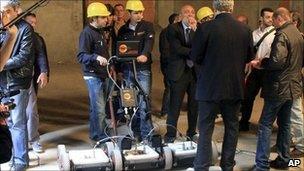Italy: Hunt begins in Florence for Mona Lisa model
- Published

The team will use a geo-radar device to search for remains
A team of researchers in Italy has begun a search for the tomb of a woman who may have been the model for Leonardo Da Vinci's painting Mona Lisa.
The team is using a special radar device at the convent in the city of Florence where it thinks the body of the woman, Lisa Gherardini, is buried.
It hopes to find skull fragments and to try to create a facial reconstruction.
The identity of the enigmatic Mona Lisa remains one of the great mysteries of the art world.
Carbon-dating
The BBC's Duncan Kennedy in Rome says although she has one of the most recognisable faces and the most enigmatic of smiles, for five centuries nobody has really known who she is.
Gherardini has long been thought to be a model who posed for the picture, although some experts say the final portrait may be a composite of other faces.
The research work is going on at the St Orsola convent in central Florence. A recently discovered death certificate suggested Gherardini died there in 1542.
She was the wife of a rich silk merchant called Francesco del Giocondo. Our correspondent says that in Italy, the painting has always been known as La Gioconda.
It is unclear whether the bones will be in any state to be of use, but the team hopes to carbon-date them and take DNA samples to test with Gherardini's descendants.